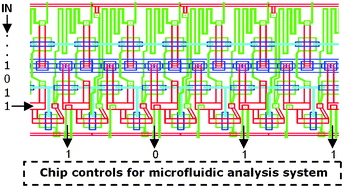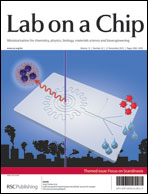Pressure driven digital logic in PDMS based microfluidic devices fabricated by multilayer soft lithography†
Abstract
Advances in microfluidics now allow an unprecedented level of parallelization and integration of biochemical reactions. However, one challenge still faced by the field has been the complexity and cost of the control hardware: one external pressure signal has been required for each independently actuated set of valves on chip. Using a simple post-modification to the multilayer soft lithography fabrication process, we present a new implementation of digital fluidic logic fully analogous to electronic logic with significant performance advances over the previous implementations. We demonstrate a novel normally closed static gain valve capable of modulating pressure signals in a fashion analogous to an electronic transistor. We utilize these valves to build complex fluidic logic circuits capable of arbitrary control of flows by processing binary input signals (pressure (1) and atmosphere (0)). We demonstrate logic gates and devices including NOT, NAND and NOR gates, bi-stable flip-flops, gated flip-flops (latches), oscillators, self-driven peristaltic pumps, delay flip-flops, and a 12-bit shift register built using static gain valves. This fluidic logic shows cascade-ability, feedback, programmability, bi-stability, and autonomous control capability. This implementation of fluidic logic yields significantly smaller devices, higher clock rates, simple designs, easy fabrication, and integration into


 Please wait while we load your content...
Please wait while we load your content...